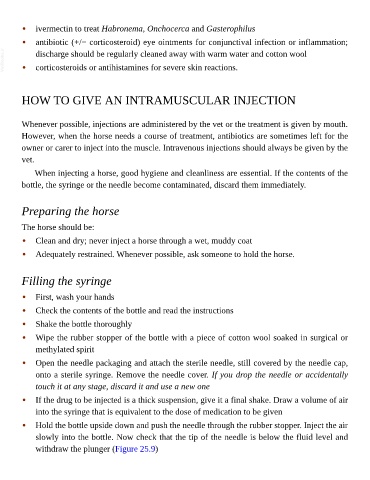Page 1128 - The Veterinary Care of the Horse
P. 1128
• ivermectin to treat Habronema, Onchocerca and Gasterophilus
• antibiotic (+/− corticosteroid) eye ointments for conjunctival infection or inflammation;
VetBooks.ir • discharge should be regularly cleaned away with warm water and cotton wool
corticosteroids or antihistamines for severe skin reactions.
HOW TO GIVE AN INTRAMUSCULAR INJECTION
Whenever possible, injections are administered by the vet or the treatment is given by mouth.
However, when the horse needs a course of treatment, antibiotics are sometimes left for the
owner or carer to inject into the muscle. Intravenous injections should always be given by the
vet.
When injecting a horse, good hygiene and cleanliness are essential. If the contents of the
bottle, the syringe or the needle become contaminated, discard them immediately.
Preparing the horse
The horse should be:
• Clean and dry; never inject a horse through a wet, muddy coat
• Adequately restrained. Whenever possible, ask someone to hold the horse.
Filling the syringe
• First, wash your hands
• Check the contents of the bottle and read the instructions
• Shake the bottle thoroughly
• Wipe the rubber stopper of the bottle with a piece of cotton wool soaked in surgical or
methylated spirit
• Open the needle packaging and attach the sterile needle, still covered by the needle cap,
onto a sterile syringe. Remove the needle cover. If you drop the needle or accidentally
touch it at any stage, discard it and use a new one
• If the drug to be injected is a thick suspension, give it a final shake. Draw a volume of air
into the syringe that is equivalent to the dose of medication to be given
• Hold the bottle upside down and push the needle through the rubber stopper. Inject the air
slowly into the bottle. Now check that the tip of the needle is below the fluid level and
withdraw the plunger (Figure 25.9)

